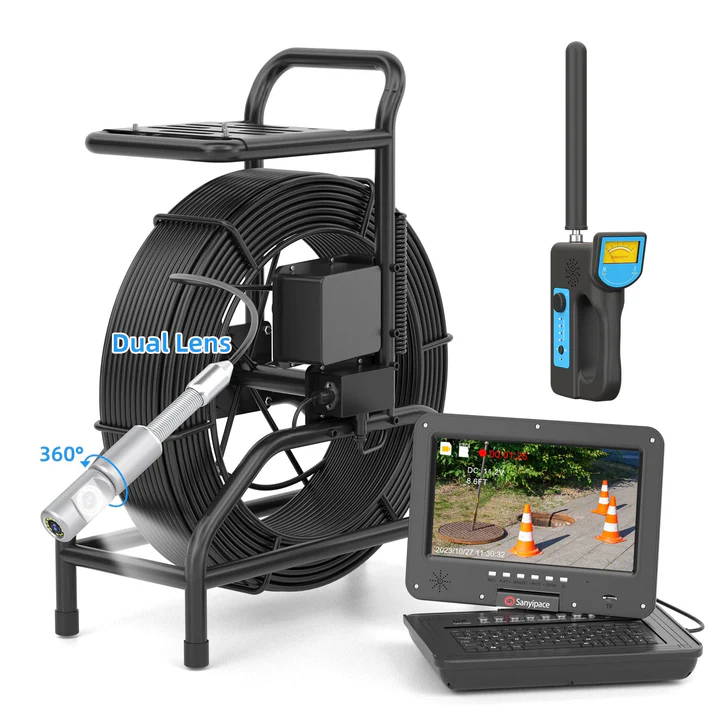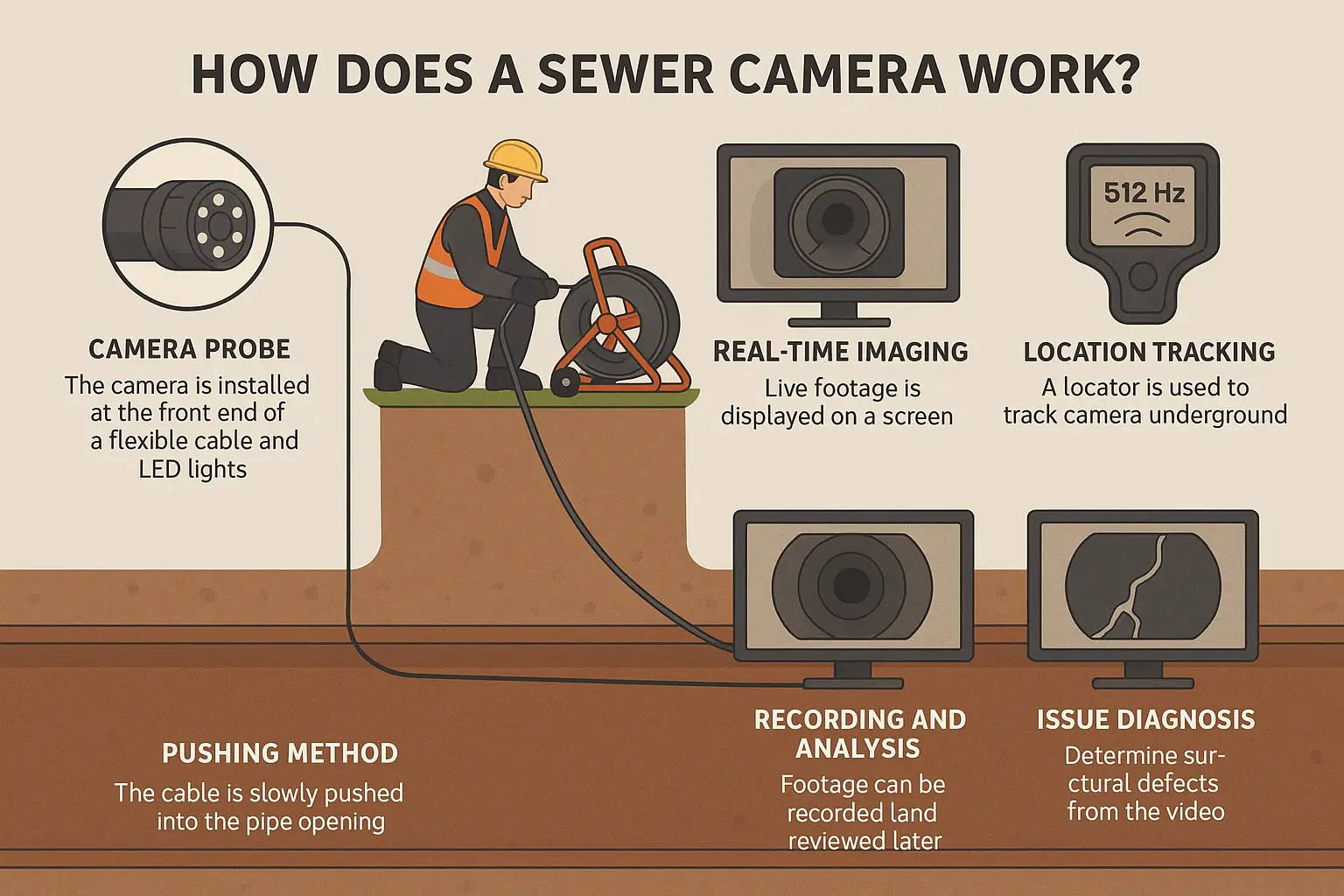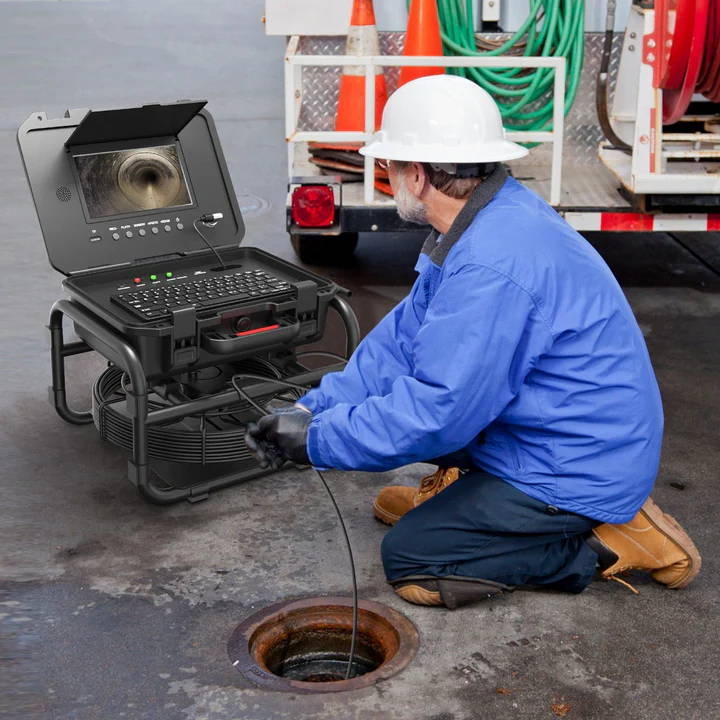Sewer Camera: What Is It & How to Pick?
If your home's drain is draining slowly, repeatedly clogging, or even emitting foul odors, it’s likely that there is a blockage or crack inside the pipes. But if you’re worried about damaging the pipes while trying to check, don’t worry – a sewer camera has become the safest and most efficient inspection method.
In this article, we will guide you through what a sewer camera is, how it works, its advantages, common usage scenarios, and how to choose the right device based on your needs.
What Is a Sewer Camera?

A sewer camera, also known as a pipe inspection camera or drain inspection camera, is a specialized tool used to visually inspect the inside of sewer lines, drainpipes, and other underground piping systems.
It typically consists of a high-definition waterproof camera, an LED light source, a display/controller, and a cable. These cameras provide real-time video footage from inside the pipe, helping users quickly locate and identify blockages, cracks, or other issues.
Main Advantages of Sewer Cameras
- Accurate Problem Detection: Effectively identifies blockages, cracks, or leaks inside the pipes, helping avoid unnecessary excavation.
- Cost-Effective Repairs: Accurate inspection reduces unnecessary digging and labor, lowering overall repair costs.
- ImprovedInspection Efficiency: Quickly scans the entire pipeline, saving time and increasing work efficiency.
- Real-Time Visualization: High-definition video provides a clear view of the pipe’s interior, making it easier to assess the severity of issues.
- Preventive Maintenance: Regular inspections help detect aging, deformation, or root intrusion early, preventing major problems down the line.
- Home Buying Assessment: Homebuyers often use sewer cameras to inspect drainage systems, ensuring the property is in good condition and avoiding unexpected repair costs after purchase.
How Does a Sewer Camera Work?

A sewer camera system typically includes a high-resolution camera head, LED lighting, a flexible push rod or robotic crawler, and a monitor or recording system.
Here's how a sewer camera works step-by-step:
- Camera probe: The camera is installed at the front end of a long, flexible cable, which is usually waterproof and equipped with an LED light to provide lighting in completely dark pipes.
- Pushing method: The operator slowly pushes the cable with the camera into the pipe opening. As the cable moves forward, the camera will capture the inside of the pipe in real time.
- Real-Time Imaging: The camera captures live footage of the pipe's interior, which is displayed on a screen. Most cameras offer HD resolution and include LED lights to illuminate the dark space.
- Location Tracking: Many systems come with a built-in sonde transmitter or 512 Hz locator, allowing operators to track the exact location and depth of the camera underground.
- Recording and Analysis: Footage can be recorded and reviewed later. Technicians can freeze frames, zoom in, or annotate videos to better understand and explain pipe conditions to clients.
- Issue Diagnosis: Based on the video, technicians determine whether there's a clog, crack, corrosion, misalignment, or other structural defect
Typical Applications of Sewer Cameras

Sewer cameras can be used in various pipeline scenarios, including the following:
1. Residential Drain Inspection
Sewer cameras are widely used in homes to inspect kitchen, bathroom, and floor drains. They help quickly locate blockages, leaks, or foreign objects, reducing the need for unnecessary dismantling and guesswork.
2. Municipal Sewer Maintenance
In city infrastructure, sewer cameras play a key role in routine inspections of underground sewer systems. They help identify risks such as sediment buildup, cracks, collapses, or root intrusion to ensure safe operation.
3. Industrial & Factory Pipe Monitoring
Industrial facilities and laboratories often have complex wastewater pipelines. Cameras help monitor corrosion, scaling, joint issues, or damage, preventing costly shutdowns and environmental hazards.
4. Real Estate Inspections
Before buying, selling, or renting a property, inspecting the drainage system with a sewer camera helps uncover hidden problems like backflow, deterioration, or pipe damage, improving transparency in property evaluations.
5. Insurance Claims & Legal Evidence
In events like pipe bursts or flooding, sewer cameras serve as vital tools for recording evidence, supporting insurance claims, and determining liability.
6. Renovation & Pre-Construction Assessment
Before repairing or installing new pipelines, a camera inspection can assess the condition of existing systems, identify potential issues, and assist in planning an effective construction approach.
7. Landscaping & Underground Obstacle Detection
During landscaping or outdoor construction, cameras help detect tree root intrusion or hidden underground obstacles, reducing the risk of damaging pipes or cables during digging.
How to Pick the Right Sewer Camera?

When selecting or buying a sewer inspection camera for home or professional use, consider the following factors:
1. Define Your Inspection Needs
Start by identifying the type of pipe you need to inspect (residential drain or municipal sewer) and your inspection purpose (locating blockages or checking for damage). Also, consider the pipe environment—whether it contains dirty water, sludge, or debris. This helps you choose the right equipment.
2. Focus on Camera Performance
Image quality and camera build are key to spotting problems. Look for a camera with 1080P HD resolution, built-in LED lights, a wide viewing angle (at least 120°), and an IP68 waterproof rating. This ensures clear visibility in dark, damp, or submerged environments.
3. Choose the Right Cable Length and Flexibility
Cable length should match your typical inspection range: 20–40 meters is often enough for household use, while commercial or municipal jobs may require 60 meters or more. The push cable should be both flexible (to navigate bends) and durable (to avoid breakage), ensuring smooth and efficient operation.
4. Make Sure Monitoring & Recording Are Convenient
A quality sewer camera system should include a large screen (7–10 inches), with video recording, playback, and file export options. Some advanced models also support Wi-Fi streaming, allowing live viewing on a smartphone or tablet—ideal for reviewing footage or communicating with clients.
5. Boost Efficiency with Locators & Distance Counters
For users who need to precisely locate issues, choose a model with a 512Hz transmitter and a compatible receiver. A built-in distance counter shows how far the camera has traveled inside the pipe, making it easier to mark the digging spot accurately and improve repair efficiency.
6. Match the Camera to Your Budget
Sewer cameras range from $300 to $5000 or more. The higher the price, the more features you typically get. For basic household inspections, an entry-level model will suffice. For professionals or contractors, a mid- to high-end model is recommended for better image clarity, durability, and advanced functionality.
✅ SANYIPACE Brand Advantages

- HD Imaging: Equipped with 1080P HD cameras that deliver clear, detailed visuals—perfect for spotting blockages, cracks, or other issues.
- Auto-Leveling: Built-in auto-leveling keeps the image upright at all times, making inspections easier to interpret.
- 360° Rotatable Screen: Large display screens can be rotated to adjust the viewing angle, providing flexibility during operation.
- LED Illumination: Multiple adjustable high-brightness LED lights ensure visibility even in pitch-dark or murky pipes.
- IP68 Waterproof Rating: Designed to withstand dirty water, sludge, and other harsh environments, giving you peace of mind.
- Durable Push Rod Cable: Flexible and wear-resistant cables can handle pipe bends and long distances, with some models reaching up to 100 meters.
- Built-in Meter Counter: Displays the exact distance the camera has traveled inside the pipe, helping pinpoint the issue depth.
- Locator Transmitter: Integrated 512Hz transmitter works with a receiver to accurately locate underground problem spots—greatly improving repair efficiency.
- Flexible Storage Options: Supports SD card/USB recording and export; select models also feature Wi-Fi connectivity for easy file sharing and remote viewing.
Whether you’re tackling everyday home issues or performing professional deep-pipe inspections, SANYIPACE offers a reliable, fully-featured solution to help you handle any sewer challenge with confidence.
Conclusion
A sewer camera is a device that simplifies the process of checking pipelines. It can help us easily check the blockage inside the pipeline, slow drainage, etc.
Compared with the traditional "blind check" method, it can accurately locate the location and type of the problem through the real-time camera image without digging or dismantling the pipeline, greatly improving the diagnostic efficiency.










